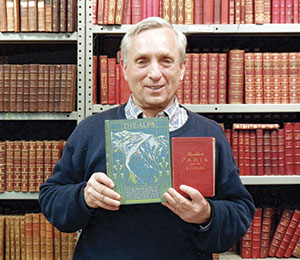
One doesn’t have to travel far to start collecting books on travel, according to Kenneth Gloss.
By Kenneth Gloss
Summer is primetime for journeys to far-away lands by way of one’s imagination and by actually making the decision to travel! A collection of travel books is a great way to sample life in other countries and learn about their culture and history whether or not one makes the necessary arrangements to turn their dream into a reality. From the very first travel guide put out by Baedekers in Germany, collectors and travelers alike have been fascinated with books that provide a colorful verbal and sometimes pictorial view of the world.
The Baedekers are some of the best guides ever produced and can sell for $10 and up, depending upon the rarity and condition. These mini-books had been written specifically to be used on trips and were not designed to last for generations. Thus, many of those guides did not survive much beyond the journeys for which they were used. Generally, though, travel guides for popular destinations like Paris, London and Germany are plentiful. In the U.S., Niagara Falls has the distinction of having the most travel guides written about it because it continues to be a perennial honeymoon and family vacation spot. Bermuda is also popular with both British and American collectors.
As one gets a little more off the beaten travel path, old guides become very rare and more valuable. Guides for Greece are rarer than for Paris, while finding a guide for a country like Syria is even rarer. Aside from today’s struggles, one of the reasons tourist books on Syria are difficult to find is that the country used to prohibit them. The old guides to Syria contain a note that advises the traveler to hide it in a pocket before crossing the border because the guards would often confiscate them. That little side note is just one of the interesting tidbits you can find tucked inside a travel guidebook.
Guides to Russia are also rare. When communism closed the borders in 1917, travel writers were not allowed in to document the sites for many years, leaving a hole in the Russian travel guide history. Russian guidebooks had been one of the best sources for accurate maps. The State Department bought many because it was one of the few places where maps for the area were available. Therefore, there are not as many of them available to collectors today. A Russian guidebook pre-the fall of the wall, will sell for $200-350 because of this imposed shortage of guidebooks.
Travel guides are more than just information; they make incredibly interesting historical references as well. If you collect all the guides available on a particular area over a large period of time, you can gain an amazing picture of the culture and society of that area. Travel guides point out what areas people deemed important, how the buildings and streets changed and what was popular at the time. Any advertisements in the book can even be a valuable reference to the society and its culture.
Travel guides were produced by a variety of transportation industries in an effort to entice people to travel. During the mid-1800s, the railroads produced a number of books that focused on the West. Some of the railroad companies even built their own hotels and resorts, and would then feature those places in the guides. The railroads were one of the biggest promoters of travel books to the public. Later, steamship companies, auto clubs and airlines began producing travel guides. Oil companies also published a number of these books, complete with listings of gas stations, as did Duncan Hines with eateries around the country. The components of the travel guide, whether it pointed out depots, gas stations or docks, were directly related to what conveyance the traveler was using and which company was producing the book.
Before photography, the pictures in travel guides were hand-drawn. Some of the artwork in these booklets is exquisite. The prints inside are often detailed enough to be framed and many collectors look for travel guides with particular artistic merits.
There are mainly two types of travel guide collectors. The first is the person who is fascinated with reading travel accounts and loves to learn about the history of different places throughout the world. They can travel the world, journeying to a different country every night, just by reading a variety of travel guides. The second is the armchair traveler, a person who may have always dreamed of circling the globe, but never got a chance. Some people spend their entire lives planning a trip to a particular destination and collecting guides about the area. It’s sad to buy these guides from an estate and learn that Grandma or Uncle Joe always dreamed of traveling to Paris, but died before that trip became a reality. A handful of travel guides from years ago were even written by armchair travelers who never went beyond their local library to gather research. These particular books don’t depict as true a picture of an area as one where the writer actually made the journey.
The best part about collecting travel guides is the cost. For relatively little money, you can start collecting these books. They are also easy to find. Travel guides pop up in boxes at garage sales, inside antique shops and at flea markets. If you are concentrating your collection on a certain area or specific time period, it may take a little more effort to find the right books but the payoff is worth it. Like the gold miners who sorted through gallons of water and tons of rock to find a single nugget, an industrious travel guide collector can search through the bookracks in a bookshop or the boxes at an auction to unearth that tiny treasure that will top off a collection.
Kenneth Gloss is the owner of the Brattle Book Shop in Boston’s Downtown section. It is the oldest antiquarian bookstore in America celebrating its 64th year of Gloss family ownership. Mr. Gloss has appeared on PBS’ Antiques Roadshow as a guest appraiser for more than a dozen years. For further information about his open talks, getting old books and documents appraised visit the website at: www.brattlebookshop.com or call 1-800-447-9595. The shop is located at 9West Street in the Downtown Crossing section of Boston.















Reader Comments